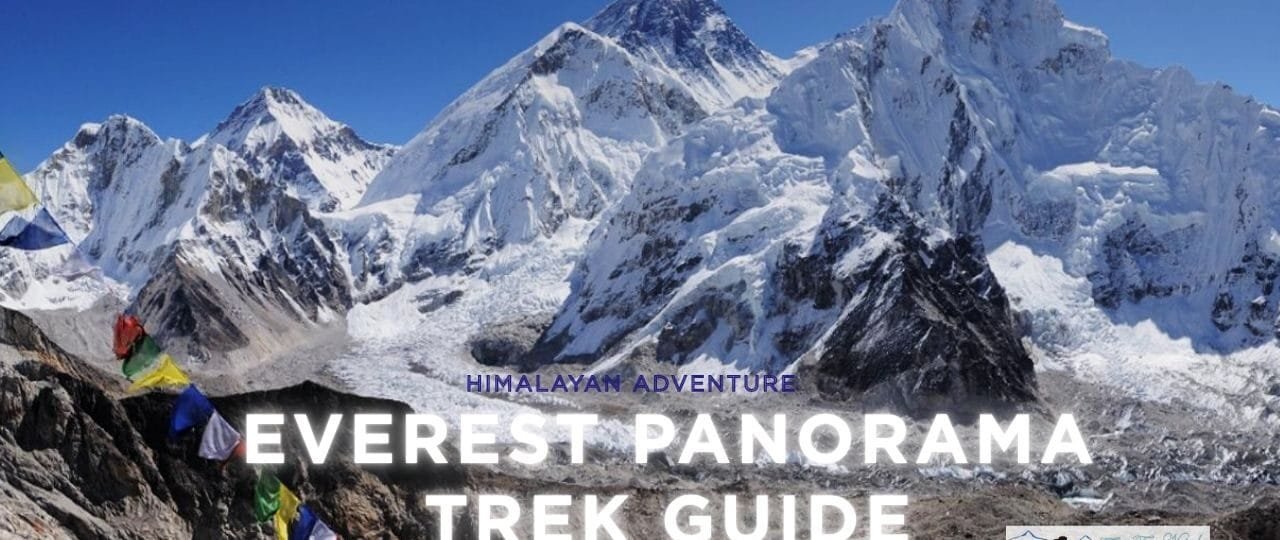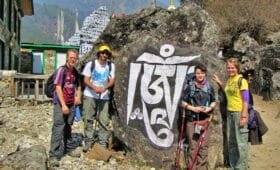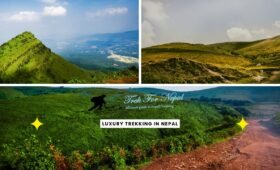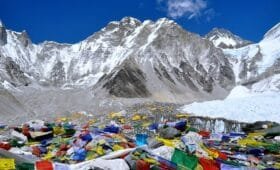The Everest Panorama Trek is a thrilling way to witness Mount Everest’s colossal majesty in a concise timeframe. This shorter route offers a taste of the Khumbu region’s culture, mountain views, and legendary Sherpa hospitality—without the weeks-long commitment of reaching Everest Base Camp. If you’re keen on experiencing iconic Himalayan peaks, exploring Buddhist monasteries, and immersing yourself in high-altitude communities, the Everest Panorama Trek might be your perfect fit.
In this extensive Everest Panorama Trek Guide article, we’ll dissect every facet of the trek: from the typical Everest Panorama Trek Itinerary and the standard Everest Panorama Trek Cost to trekking route details, difficulty levels, permit essentials, and how to seamlessly incorporate philanthropic endeavors via Volunteers Initiative Nepal (ViN). Whether you’re a first-time trekker craving an accessible trek or a more advanced hiker wanting a scenic break, the Everest Panorama Trek provides awe-inspiring panoramas of Everest, Lhotse, Nuptse, and Ama Dablam—making it an unforgettable adventure in the Khumbu.
Introduction
1. Introduction: Why the Everest Panorama Trek?
Many travelers aspire to see Mount Everest up close but are deterred by the demands of the entire Everest Base Camp route. The Everest Panorama Trek offers a gentler itinerary, culminating around Tengboche or Pangboche—enough to glimpse Everest’s grandeur without crossing extreme altitudes. Think of it as a condensed Everest experience: mountain flights to Lukla, crossing suspension bridges over raging rivers, glimpsing sherpa villages with yak caravans, and immersing in Tengboche Monastery’s spiritual ambiance.
Statistic: According to Nepal Tourism Board data, the Everest region hosts over 45,000 trekkers a year, but a growing proportion (nearly 25%) pick shorter routes like the Everest Panorama Trek. The ease and moderate altitudes (max ~3,870m at Tengboche) make it appealing to families, seniors, or those short on time.
Quote:
“I wanted to see Everest but only had seven days to spare. The Everest Panorama Trek was a perfect compromise—short, scenic, and culturally rich,” says Martina, a 31-year-old traveler from Germany who completed the route last autumn.
History
2. Historical & Cultural Overview
Nepal’s Khumbu region, known worldwide as the gateway to Everest, has a deeply rooted Sherpa heritage. Sherpas migrated from eastern Tibet centuries ago, cultivating a Buddhist culture that endures in monasteries, chortens, and prayer wheels scattered along the trails. Tengboche Monastery, the spiritual highlight of the Everest Panorama Trek, was founded in the early 20th century and remains central to Sherpa traditions.
1976 the government established Sagarmatha National Park to safeguard the area’s fragile alpine environment and distinctive culture. Since then, teahouses catering to trekkers have proliferated in Phakding, Namche Bazaar, and beyond. This synergy between tourism, local business, and Sherpa lifestyles weaves into an iconic trekking tapestry—merging mountaineering lore, Buddhist devotion, and modern commerce. Meanwhile, the Everest Panorama Trek route ensures that newcomers to the Himalayas can see the region’s highlights without the intense altitudes demanded by the entire Everest Base Camp trek.
Trek Itinerary
3. Key Highlights of Everest Panorama Trek Itinerary
A standard Everest Panorama Trek Itinerary typically spans 7–9 days, though some travelers compress it to 5–6 if skipping certain acclimatization or side trips. Here’s a typical outline:
Day 1: Flight from Kathmandu to Lukla (~2,840m) → Trek to Phakding (~2,610m)
A thrilling 30-minute flight into Lukla. Hike for ~3 hours, descending slightly to Phakding, crossing scenic suspension bridges over the Dudh Koshi River.
Day 2: Phakding → Namche Bazaar (~3,440m)
Trails lead through pine forests, passing villages like Monjo and the Sagarmatha National Park checkpoint. A steep final climb emerges at Namche Bazaar, the Sherpa capital, boasting shops, bakeries, and lodges.
Day 3: Acclimatization in Namche Bazaar
Short hikes to Syangboche or the Everest View Hotel (~3,880m). Panoramic Everest, Lhotse, and Ama Dablam vistas at sunrise. Explore Namche’s local museum or bazaar in the afternoon.
Day 4: Namche Bazaar → Tengboche (~3,870m)
A moderate trek with a steep final push to Tengboche Monastery. Stunning vantage of Everest’s summit, especially at dawn. Some stay in nearby Debuche for quieter lodging.
Day 5: Tengboche → Return to Namche
Enjoy a morning monastery visit. Retrace steps downhill, crossing rhododendrons and pine forests.
Day 6: Namche → Lukla
A more extended day descending the main route. Reflect on the Himalayas’ energy as you pass Sherpa villages again.
Day 7: Flight Lukla → Kathmandu
Weather permitting, you’ll fly out early. Before heading back to the city, you can optionally extend your trek or volunteer with local communities.
If you add side trips to Khumjung or Pangboche, the Everest Panorama Trek Duration can shift. Some also incorporate advanced vantage points, like heading a half-day beyond Tengboche for a clearer Everest view.
Trek Difficulty
4. Understanding the Everest Panorama Trek Difficulty
The Everest Panorama Trek Difficulty is moderate, with altitudes around ~3,870m at Tengboche. Key challenges:
- Altitude: Some might experience mild sickness near Namche or Tengboche.
- Steep Climbs: Namche’s final uphill is infamous for testing your legs. Lukla to Namche transitions can also be strenuous.
- Variable Weather: Lukla flights can be delayed by wind or cloud, forcing schedule flexibility.
This route is suitable for novices with decent fitness or families who want a taste of Everest’s splendor without the intense altitudes of EBC. Acclimatization days (like in Namche) help your body adjust. If you pace well, the short daily distances remain feasible for most.
Trek Mapping
5. Mapping Your Route: A Look at the Everest Panorama Trek Map
A comprehensive Everest Panorama Trek Map focuses on the following:
- Lukla (~2,840m): Trekking gateway where flights land.
- Phakding (~2,610m): First overnight stop.
- Monjo / Jorsalle (~2,835m): Sagarmatha National Park checkpoint.
- Namche Bazaar (~3,440m): Hub of Sherpa culture, acclimatization point.
- Everest View Hotel (~3,880m) or Syangboche (~3,720m): Scenic day-hike vantage.
- Tengboche (~3,870m): Spiritual highlight, a monastery perched on a ridge with unmatched Everest glimpses.
Some trek beyond Tengboche to Debuche or Pangboche for quieter lodging and a better vantage point. The standard route doubles back, with the total Everest Panorama Trek Distance around ~45–50 km, depending on side trips.
Trek Costing
6. How Much Does It Cost? Explaining the Everest Panorama Trek Cost
The Everest Panorama Trek Cost remains lower than the entire EBC trek, thanks to fewer days and lower altitudes. Key cost components:
- Permits:
- Sagarmatha National Park entry (~USD 30).
- Khumbu Rural Municipality fee (~NPR 2,000, ~USD 17–20).
- TIMS card is often not mandatory in Khumbu but check current rules.
- Transport:
- Round-trip Kathmandu–Lukla flight: ~USD 180–200 each way for foreigners.
- Food & Accommodation:
- Teahouses: ~USD 5–10 per night.
- Meals: ~USD 25–30 daily, rising with altitude.
- Guide & Porter (optional but beneficial):
- ~USD 25–30/day for a guide. ~USD 15–25/day for a porter.
- Misc:
- Lukla flight cancellations might require extra days or a helicopter rescue (expensive).
- Wifi or charging fees: ~USD 2–5 daily.
- Equipment rental and personal trekking gear if needed.
A 7–9 day itinerary, excluding flights, might cost ~USD 600–900 if teahouse-based. An Everest Panorama Trek Package that includes flights, lodging, a guide, and partial meals might cost ~USD 1,000–1,400, depending on agency and comfort level.
Booking Trek
7. Booking the Right Everest Panorama Trek Package
Many travelers prefer an Everest Panorama Trek Package for convenience, including:
- Round-trip Lukla flights (or bus to Ramechhap if necessary).
- Permits & Paperwork: Freed from local permit lines.
- Guide & Porters: Cultural insights, altitude management, logistic support.
- Lodging & Some Meals: High-season nights at Namche can get crowded, but packages usually pre-book teahouses.
Research agencies for their experience, local staff wages, and trek flexibility. Everest Panorama Trek Reviews from previous clients help confirm reliability and safety standards.
Trek Permits
8. Securing Everest Panorama Trek Permits
Everest Panorama Trek Permits revolve around:
- Sagarmatha National Park Entry Permit (~USD 30).
- Khumbu Rural Municipality Permit (~NPR 2,000, ~USD 17–20).
- TIMS Card: It may be waived in the Khumbu region, but rules can change. Confirm with your guide or local tourism office.
Bring your passport and visa copies, plus a few passport-sized photos. The agency usually manages permits if you buy an Everest Panorama Trek Package.
Best Timing
9. Everest Panorama Trek Best Time: Seasons & Weather
Everest Panorama Trek Weather changes drastically with altitude and seasons. The recommended windows:
Mon cause on (Jun–Aug): FrequeFewer trekkers use the trail during this season. Clouds often obscure Everestsees fewer trekkers. Clouds obscure Everest often, but greenery intensifies.
Autumn (Sept–Nov): Clear skies, moderate temperatures (~15–20°C in lower parts, near freezing at night above 3,500m), and crisp mountain views.
Spring (Mar–May): Rhododendron blooms, mild days, occasional afternoon clouds or showers. Evenings remain cool.
Winter (Dec–Feb): There are minimal crowds, and there are sub-zero nights near Tengboche, but the town is usually open. However, Lukla flight delays are possible due to wind or snowfall.
Hiring Guide
10. Hiring an Everest Panorama Trek Guide
Although the route is well-trodden, an Everest Panorama Trek Guide offers several benefits:
- Cultural Insight: Guides share Sherpa traditions, local stories, and hidden vantage points.
- Altitude Safety: They help manage pacing and watch for mild sickness near Tengboche.
- Logistics: They navigate teahouse availability and coordinate rescue if flights are canceled or illness arises.
- Local Economy: Hiring local staff fosters sustainable tourism in Khumbu.
Rates for a licensed guide are ~USD 25–30/day, which can be split among multiple trekkers. Porters cost ~USD 15–25/day. Some travelers skip both, but a guide elevates the cultural experience and ensures safety.
Tips
11. Preparation & Tips for Success
11.1 Physical Training
- Cardio: Regular running or fast-paced walking for ~4–6 weeks prior.
- Leg Strength: Weighted stair climbs or lunges replicate the steep sections near Namche.
- Backpack Familiarity: Practice with ~7–10 kg to adapt your shoulders.
11.2 Gear & Clothing
- Layering: Thermal base, fleece jacket, down jacket, windproof shell.
- Footwear: Durable, broken-in trekking boots.
- Extras: Trekking poles, headlamp, power bank, personal medication, and possibly a 3–4 season sleeping bag for winter or high altitudes.
11.3 Altitude Strategy
Everest Panorama Trek’s Altitude peaks around 3,870m near Tengboche. Some day hikes approach 4,000m. An acclimatization day at Namche (3,440m) helps. Drink ~3 liters daily, slow your pace and rest if mild headache or breathlessness occurs.
Testimonials
12. Stories from the Trail: Testimonials & Inspiration
Julia’s Short Escape
Julia, a 27-year-old teacher from the UK, chose the Everest Panorama Trek because she only had nine days in Nepal.
“The moment I glimpsed Everest from Syangboche, I felt an overwhelming sense of wonder. Even though I didn’t go to base camp, it was enough to satisfy my dream of seeing the world’s highest peak.”
Local Legacy
Tsering, a lodge owner near Tengboche, emphasizes how short treks still bolster local communities.
“Many short-route trekkers buy local crafts or volunteer daily in village schools. We appreciate that. They might not stay as long as EBC trekkers, but each contribution helps us maintain footpaths and supports families’ incomes.”
FAQs
13. Seven Most Frequently Asked Questions
Below are seven popular queries about the Everest Panorama Trek gleaned from internet searches and traveler forums:
How long is the Everest Panorama Trek Duration?
Typically, it takes 7–9 days, though some do a 5–6-day version if skipping acclimatization or side hikes.
What is the Everest Panorama Trek Difficulty rating?
Generally moderate, peaking near 3,870m at Tengboche. Suitable for novices or those wanting a short Everest taste.
How much does the Everest Panorama Trek Cost?
Expect ~USD 600–900 for ~7–8 days if you budget carefully (lodging, food, flight Lukla). An Everest Panorama Trek Package could be ~USD 1,000–1,400.
Do I need any Everest Panorama Trek Permits?
Yes. Sagarmatha National Park (~USD 30) plus the Khumbu Rural Municipality fee (~NPR 2,000, ~USD 17–20). TIMS may not always be required in Khumbu, but confirm current regulations.
When is the Everest Panorama Trek Best Time?
Autumn (Sept–Nov) or spring (March) for stable weather, warm days, and minimal flight disruptions. Winter sees fewer crowds but colder nights.
Do I need an Everest Panorama Trek Guide?
It is not mandatory but recommended for cultural immersion, navigation, altitude safety, and local insight.
What altitude do we reach on this trek?
The highest sleeping altitude is Tengboche (~3,870m). Some day hikes near Syangboche approach ~3,900–4,000m.
Conclusion
From flight drama into Lukla to the final vantage of Everest’s summit from Tengboche Monastery, the Everest Panorama Trek encapsulates a condensed yet mesmerizing Himalayan journey. This trek merges scenic wonders, moderate altitude gains, and the intangible allure of Sherpa traditions. Each day fosters a deeper appreciation for the synergy of nature, spirituality, and local resilience in one of the world’s most iconic mountain regions.
Combine Trekking & Community with ViN
At Volunteers Initiative Nepal (ViN), we champion weaving philanthropic work into your trek, ensuring local communities benefit from tourism’s reach:
- Share: Spread the ethos among friends or social media, fostering a mindful tourism culture beyond personal adventure.
- Volunteer: Dedicate spare days to teaching English in Lukla or Namche or offering health awareness sessions.
- Donate: Provide resources that enhance local schooling or environmental projects.
- Intern: Align your academic or professional aims—like sociology, environment, or healthcare—with real needs in these mountain villages.
Namaste, and may your footprints on the Everest Panorama Trek echo not just personal but also empathy, empathy, and solidarity across the Khumbu. Let’s co-create a future where mountain journeys empower local communities and preserve these majestic Himalayan landscapes.
Additional Tips
Deep Dive: Additional Info & Practical Tips
We’ve explored the fundamentals, but let’s refine your knowledge with advanced nuances, route expansions, volunteering synergy, and more.
1. Seasonal Weather & Variation
1.1 Autumn (Sept–Nov)
Typically, it is the busiest but stable. Crisp mountain views, fewer flight cancellations, and nights near 0°C at Tengboche.
1.2 Spring (Mar-May)
Blooming rhododendrons add color to forests. Midday temperatures are warm (10–15°C) around Namche, cooler near 3,700m.
1.3 Winter (Dec–Feb)
Sub-zero nights above 3,000m. Quieter trails. Lukla flights risk weather delays. Perfect for those who love solitude and can handle cold.
1.4 Monsoon (Jun–Aug)
request downpours leeches in lower forests, flight disruptions. But the route from Lukla remains doable if you handle mud and adapt. Clouds might obscure Everest.
2. Route Extensions
2.1 Pangboche or Dingboche
Some travel an extra day or two to Pangboche (~3,930m), enjoying a more intimate vantage point of Ama Dablam. However, it is still short of major altitudes like EBC.
2.2 Return via Mong La
From Tengboche, one could loop to Mong La (3,975m) for an alternative viewpoint, then rejoin near Namche. This adds variety to the return route.
3. Cultural Nuances
3.1 Sherpa Hospitality
Sherpas are known for their warmth, and they live in harmony with harsh Himalayan conditions. A quick chat about daily life or mountaineering history in teahouses can deepen your appreciation of local heritage.
3.2 Monastery Etiquette
When visiting Tengboche or smaller gompas, remove shoes and hats upon entering. Seek permission before photographing certain religious activities.
4. Potential Challenges & Solutions
- Flight Delays: Lukla’s short runway and weather volatility cause frequent cancellations. Build a buffer day or two in your itinerary.
- Altitude: While ~3,870m is moderate, mild headaches or insomnia can strike. Slow ascents and an extra day near Namche help.
- Crowding: On autumn weekends, teahouses in Namche or Tengboche might be packed. Arrive early or pre-book via a package.
5. Volunteering with ViN
5.1 Pre-/Post-Trek
Volunteers Initiative Nepal can coordinate short stints near Lukla or Kathmandu before or after your trek. Some choose 2–3 day school visits in Namche or cultural immersion sessions.
5.2 In-Route
Time constraints can hamper longer volunteer efforts. However, a short session in Lukla or synergy with local clubs fosters beneficial interactions. Consider donating stationery, sponsoring a small library, or assisting in environment cleaning.
6. Reflection & Next Steps
Many find the Everest Panorama Trek a stepping stone to advanced Himalayan ventures—like the entire Everest Base Camp trek or even island peak climbs. Others remain satisfied with these ephemeral but intense glimpses of Everest’s majesty, returning home with a new respect for the Sherpa way of life and Himalayan ecosystems.




